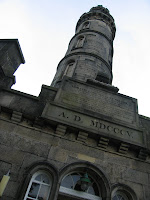 Stewart Memorial Foutain, image from BBC website
Stewart Memorial Foutain, image from BBC website The A-listed fountain is located in Kelvingrove Park and was built in 1872 to commemorate Robert Stewart, the city’s Lord Provost from 1851 to 1854, who fought for Glasgow’s clean water system.
BGS Building Stone Team provided a stone match for the Stewart memorial fountain in spring 2009 which identified suitable stone types for its refurbishment. The original stone used in the fountain was most likely from a high quality local Glasgow blonde sandstone quarry (i.e. Bishopbriggs or Giffnock quarries); however, all of these quarries are currently closed and a suitable alternative match had to be identified for new replacement stone.
The fountain was turned on last week and can be visited in Kelvingrove Park, Glasgow.
Water flows in memorial fountain
BBC article, 14 October 2009
http://news.bbc.co.uk/1/hi/scotland/glasgow_and_west/8305572.stm

